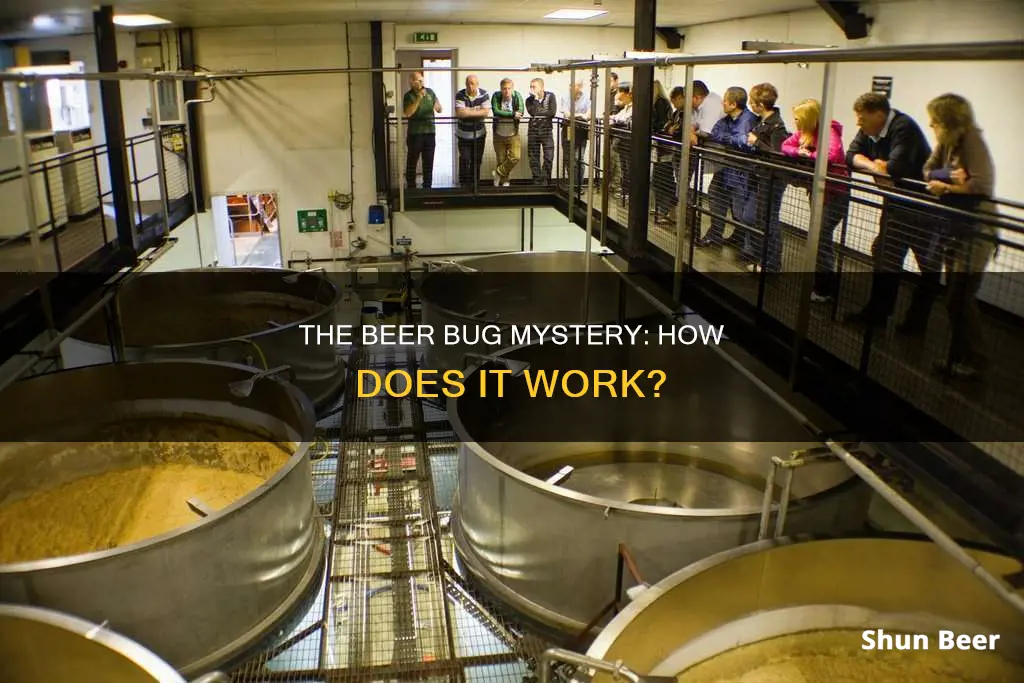
The BeerBug is a cloud-connected digital hydrometer that can be used to monitor the fermentation of beer. It is a weighted buoy that is hung down into the fermenting fluid and acts as a traditional hydrometer. This device works based on the Archimedes principle, which states that the force exerted on a body immersed in a fluid is equal to the weight of the fluid that the body displaces. The BeerBug can be set up with a laptop or a phone, and it provides instant feedback on the fermentation process, allowing brewers to make adjustments as needed.
In addition to the BeerBug, there is also a type of insect commonly referred to as beer bugs or picnic bugs. These are small beetles, about 5-8 mm long, that are attracted to beverages such as beer. They are known to cause severe damage to crops when their numbers are high.
| Characteristics | Values |
|---|---|
| Common Name | Beer Bug |
| Scientific Name | Glischrochilus quadrisignatus |
| Size | 5-8mm (1/4 inch) long |
| Colour | Dark with two yellow spots on each wing cover |
| Flying Ability | Poor flyer |
| Food | Beer and other beverages, raspberries, strawberries, tomatoes, sweet corn |
| Seasonality | Begin to appear in mid-June, peak in numbers between mid-July and early August |
| Pest Control | Traps designed for fruit flies or wasps |
| Pest Control Bait | Fresh beer, sliced bananas, 2-day-old sliced immature sweet corn |
What You'll Learn

What is a beer bug?
A beer bug can refer to two different things.
Firstly, a beer bug is a colloquial name for a sap beetle, a small beetle about 5-8mm long, dark in colour with two noticeable yellow spots on each wing cover. These beetles are attracted to beer and other beverages and are commonly found at barbecues and other outdoor events. Beer bugs are primarily an agricultural pest, feeding on a wide variety of fruits and vegetables and can cause severe damage to crops.
Secondly, the BeerBug is a cloud-connected digital hydrometer used in the process of brewing beer. It features a torpedo that hangs down into the fermenting fluid and acts as a traditional hydrometer, measuring the specific gravity of the wort.
Buttermilk Beer Batter: Does Druesteaz Mix Work?
You may want to see also

How does the BeerBug monitor fermentation?
The BeerBug is a cloud-connected digital hydrometer that helps monitor the fermentation process. It has a torpedo-shaped design that hangs down into the fermenting fluid and acts as a traditional hydrometer. This is based on the Archimedes principle, which states that the force exerted on a body immersed in a fluid is equal to the weight of the fluid displaced by the body.
The BeerBug provides real-time feedback on the fermentation process, including temperature readings. It is recommended to set up the BeerBug a day or two before brew day to allow for data population. The BeerBug should ideally be added after the initial setup is complete, as it can provide odd readings if added too early in the process.
To ensure accurate temperature readings, it is important to differentiate between the temperature readings from the BeerBug and those from an external temperature probe. The BeerBug's temperature readings reflect the room temperature rather than the wort or beer temperature. Additionally, it is crucial to use a blow-off on the conical instead of relying on the BeerBug to read the temperature of escaping CO2 during fermentation, as this can influence the temperature readings.
The BeerBug provides valuable data during the fermentation process, allowing brewers to make informed decisions. It is a useful tool for monitoring fermentation and can be easily set up using a laptop or a phone.
Understanding Beer Siphons: How Do They Work?
You may want to see also

What is a ginger bug?
A ginger bug is a starter culture made from ginger, water, and sugar. It is used to ferment drinks such as ginger beer, root beer, herbal tea, and fruit juices. The ginger skin has a large number of bacteria and yeast that are activated when mixed with the other ingredients. The water is oxygenated, activating the microorganisms and encouraging their multiplication.
To make a ginger bug, combine about 1 tablespoon of grated unpeeled organic ginger, 1 tablespoon of sugar, and 1.5 cups of water in a glass jar. Stir vigorously, cover the jar with a breathable cloth, and feed your bug 1 tablespoon of grated ginger and 1 tablespoon of sugar daily. After about 5 days, the bug should be ready to use—it will bubble and smell yeasty, with a cloudy yellow color and sludgy-looking white stuff at the bottom of the jar.
Once your ginger bug is ready, you can use it to make natural sodas like ginger ale and slightly alcoholic drinks like ginger beer. You can also use it to ferment sweetened tea or to make fizzy lemonade.
The Ultimate Beer Snorkel Experience: How Does It Work?
You may want to see also

How do you make a ginger bug?
A ginger bug is a wild-fermented starter culture made with sugar, ginger, and water. It takes about a week of daily feedings to make one, and you can use it to make probiotic, naturally bubbly soft drinks, sodas, herbal beers, and tonics.
To make a ginger bug, you'll need:
- Organic, unpeeled fresh ginger
- Sugar or another caloric sweetener
- Filtered or spring water
- On the first day, mix water with sugar and ginger and allow it to culture in a sealed jar for 24 hours.
- Every day for the next 4 to 6 days, add a small amount of fresh ginger and sugar to the bug.
- If your ginger bug begins to foam and bubble or if it smells yeasty like bread or beer, it's ready to use. You can use it right away or transfer it to a fridge for up to 1 week.
It's important to note that the wild bacteria and yeast in your kitchen and on the ginger itself will proliferate and grow. These microorganisms eat the sugar in your bug and produce carbon dioxide as a result. This is what gives your homemade sodas their bubbles.
Fitbit Beers: Compatible with Pixel 2?
You may want to see also

What is Belgian Beetles Beer?
Belgian Beetles Beer is a novel Belgium blond beer that contains insect vitamins and proteins. Its creator, Patrick Fiore, describes the flavour as "rich in taste, light sweet, a little bitter with seductive hopped flavours". The beer is said to get its "golden character" from a secret mix of "novel foods", full of proteins and vitamins.
Fiore explains that the beer was created by accident when a beetle flew into a self-made radio frequency machine used for drying and sterilizing hops, turning it into a dry powder. This powder was then examined by professors and experts who found that it was rich in proteins and vitamins, giving the beer a unique taste.
Belgian Beetles Beer is part of a growing trend of using insects in food and beverage products, with proponents arguing that insects will need to become a part of our diets due to changing dietary requirements and farming conditions. While some may be hesitant to try insect-based products, Belgian Beetles Beer provides an opportunity to experience the benefits of insect-based nutrition while also enjoying a unique and flavourful beer.
In addition to Belgian Beetles Beer, there have been other experiments with adding insects to the brewing process. For example, scientists at NC State University have been making beer with yeast from bees, wasps, hornets, and beetles. They argue that yeasts, which are responsible for converting sugar to alcohol in fermented foods, can be found on these insects and could be used to create new and interesting beer flavours.
Beer Hair Wash: Does it Work?
You may want to see also
Frequently asked questions
A beer bug is a small beetle, about 5-8mm long, that is dark in colour with two noticeable yellow spots on each wing cover. They are commonly referred to as 'picnic bugs' and are attracted to beverages like beer.
Yeast from the beer bug can be isolated and used in brewing beer. This can lead to new flavours of beer.
The best method is to make traps that will attract the beetles and place them away from where you will be sitting.







